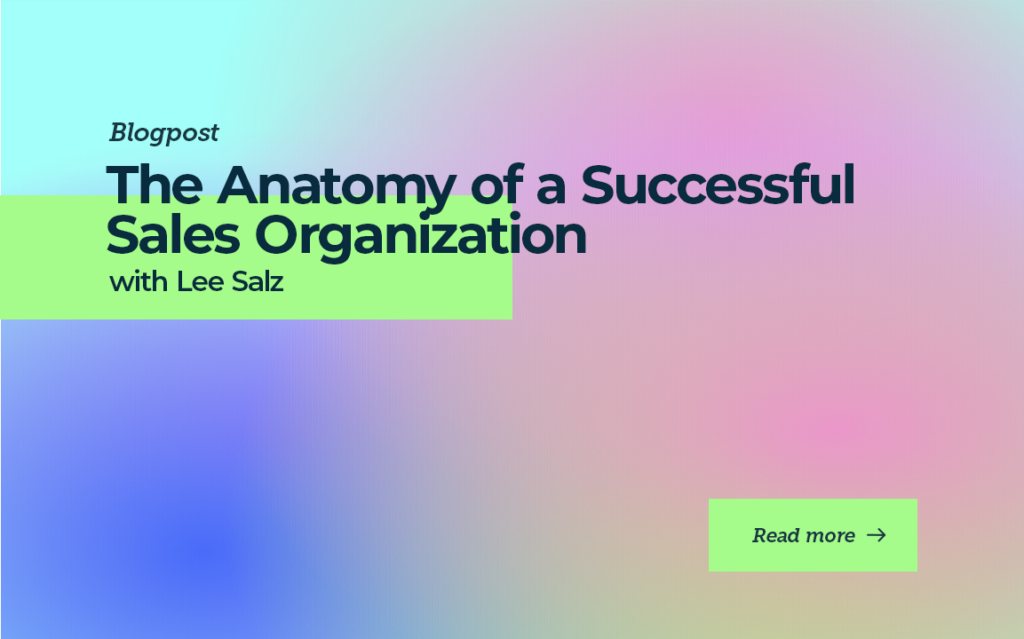The Anatomy of a Successful Sales Organization with Lee Salz

In an insightful episode of the Predictable Revenue Podcast, host Collin Stewart engages with Lee Salz, best-selling author and sales management strategist at Sales Architects.
They explore a critical yet often neglected aspect of business: the pitfalls commonly encountered in building robust sales organizations. This conversation sheds light on the importance of moving from a people-centric approach to a process-driven strategy in sales, revealing critical insights for lasting success in this dynamic field.
The Shift from People-Based to Process-Based Sales Teams
In the realm of sales, team management dynamics are often clouded by the allure of star salespeople.
However, Lee Salz brings a different perspective, one rooted in process rather than personnel. He shares an intriguing case study of a Minor League baseball team that faced high employee turnover in sales roles.
By pivoting their focus from individual sales talents to establishing robust sales processes, they experienced more stable and consistent sales outcomes. This shift highlights a critical lesson: the sustainability of sales success relies more on systematic processes than on the prowess of individual salespeople.
Strengthening the Sales Process for Consistency
Lee points out a common scenario in many sales organizations – an over-reliance on salespeople without a solid, underlying process. Such dependency leads to erratic results and leaves the organization vulnerable to the impacts of staff turnover. He argues that the foundation of a resilient sales team lies not in the individual capabilities of its members but in the strength and clarity of its sales processes.
Navigating Economic Challenges with a Strong Sales Strategy
The conversation then turns to the impact of economic conditions on sales teams. Lee observes that favorable economic conditions can often mask underlying issues in sales organizations.
In contrast, challenging economic times can expose a lack of strategy and a weak sales process, leading to hasty and ineffective solutions. He emphasizes the importance of having a well-defined sales strategy that can withstand the test of varied economic climates.
The Role of a Sales Playbook in Training and Consistency
As Lee notes, creating and implementing a sales playbook is essential in building a successful sales team. This playbook is the cornerstone for sales training, providing a consistent framework and tools.
Without such a guide, sales training risks being a temporary fix – like heated atoms that eventually return to their original state once the heat source is removed. A well-documented sales strategy ensures that the benefits of training are sustained over time, leading to long-term success.
Building Long-Term Success over Short-Term Gains
The podcast illuminates the importance of designing sales organizations for long-term, consistent results rather than focusing on short-term motivational spikes. This approach fosters steady growth and resilience, crucial in the ever-changing sales landscape.
Evolving the Sales Organization: From Departments to Forces
Lee brings to light an intriguing perspective on sales organization maturity. He delineates three stages of growth – starting from a basic sales department, evolving into a more cohesive sales team, and finally maturing into a well-oiled sales force.
Each stage marks a significant stride in how a sales organization operates, with a mature sales force characterized by consistent, predictable results and a deeply embedded, structured sales process.
The Six Pillars of Sales Maturity
Sales maturity isn’t just a concept; it’s a measurable state. Salz introduces six critical components that define the maturity of a sales organization: new client acquisition, account management, sales management, hiring, onboarding, and compensation.
The maturity of each of these aspects determines the overall effectiveness and efficiency of the sales force. By evaluating and optimizing these components, a sales organization can move towards maturity, marked by better results and more streamlined operations.
Salz introduces a comprehensive assessment tool to aid business owners, executives, and sales leaders in this journey. This tool isn’t just a diagnostic instrument; it’s a guide to improvement.
It evaluates your sales organization’s current state and provides actionable insights on areas that require development. This tool is a gateway to transforming your sales approach from haphazard to strategic, ensuring that your sales force isn’t just working hard and smart.

From Idealism to Realism in Client Acquisition
Refining the approach to new client acquisition is vital to the maturation process. Salz points out a common pitfall in sales – the pursuit of an ‘ideal client profile,’ which often leads to missed opportunities. He advocates for a more pragmatic ‘target client profile,’ focusing on who genuinely values your offer. This shift from idealism to realism in client acquisition can significantly enhance a sales team’s effectiveness.
One of the most compelling insights from Salz is the importance of understanding value perception in sales. He notes that many sales organizations chase deals without considering whether the potential client sees enough value in the product or service to justify the price. This lack of understanding of the client’s value perception can lead to missed deals and wasted efforts.
The Evolutionary Role of Sales Leaders
Reflecting on his journey, Collin stresses the importance of a sales leader’s role in nurturing new sales reps. It’s not about cloning one’s success methods but helping each rep find their unique path to success. This approach fosters a diverse and dynamic sales force where each member contributes their strengths to the collective success.
Account Management vs. Customer Service
One of the critical topics Lee Salz touches upon is the differentiation between account management and customer service. While customer service is about timely and accurate responses to client needs, account management goes several steps further.
It is a proactive approach that adds value beyond the core product or service. This distinction becomes increasingly significant as sales organizations evolve. Mature sales forces demonstrate strategic account management, focusing on understanding and fulfilling the potential and needs of each client.
Evolving Sales Management for Organizational Growth
The conversation with Collin Stewart then shifts to the broader sales management challenges. Lee advocates for a structured and systematic approach, extending beyond mere training. Aspects like pipeline management and realistic forecasting play a crucial role. He criticizes arbitrary deal forecasting, suggesting a more disciplined process with clear stages and criteria. This approach not only aids in accurate forecasting but also guides sales teams toward consistent success.
Resources for Aspiring Sales Managers
Understanding new sales managers’ hurdles, Lee and Collin recommend essential resources. Lee’s book, “Hire Right, Higher Profits,” and Mike Weinberg’s “Sales Management Simplified,” offer practical advice and strategies for effective sales team management. These resources are precious for managers seeking to contribute significantly to their organization’s growth.
Both Lee and Collin emphasize sales managers’ transformative role in transitioning from a basic sales department to a sophisticated, process-driven sales force.
Effective sales management is not just about overseeing a team; it’s about nurturing the team’s growth, aligning sales strategies with organizational goals, and fostering a culture of continuous improvement.
Rethinking the Hiring Process
Lee Salz brings a fresh perspective to hiring in sales. He challenges the conventional notion of inherently “great salespeople” and stresses the importance of finding the right fit for specific roles. This nuanced approach requires a deep role analysis and a candidate evaluation process tightly aligned with performance factors. It’s not just about hiring a good salesperson; it’s about hiring the right salesperson for the right role.
Gone are the days of “firehose treatment” or “phone book onboarding.” Lee advocates for a structured onboarding experience clearly outlining what a salesperson needs to know, do, and use. This approach ensures new hires are not just bombarded with information but are given a clear pathway to mastering essential skills and tools.
Regular assessments during onboarding are crucial to measure the effectiveness of the training and identify any gaps early on.
Transforming Hiring and Onboarding
Salz reiterates that the key to successful hiring in sales isn’t finding inherently “great salespeople” but instead identifying individuals with the potential to excel in specific roles. This approach necessitates a structured onboarding process to reverse-engineer the desired outcomes.
Such a strategy includes comprehensive assessments to validate training effectiveness and ensure the new hire’s compatibility with the role.
Viewing Salespeople as Revenue Investments
One of Lee’s key concepts is treating salespeople as revenue investments. This perspective shifts the focus from mere employment to an investment-driven approach. When a company hires a salesperson, it’s making a financial commitment with the expectation of a return. This outlook transforms how salespeople are managed post-hiring, emphasizing the importance of aligning their activities with the company’s strategic goals.
Effective Sales Management Post-Hiring
Once a salesperson is onboarded, the management style should reflect the investment mindset. Lee suggests employing a sales business plan template for salespeople, a roadmap guiding them to meet and exceed expected returns.
Regular check-ins should focus on performance relative to the plan, preventing micromanagement and focusing on constructive guidance and support.
Distinguishing Between Sales Functions
The conversation between Collin and Lee also sheds light on the importance of understanding the different functions within sales. From customer service to account management and customer success, each role contributes uniquely to the sales strategy and overall success. Recognizing and valuing these distinct functions is crucial in building a robust and efficient sales organization.
Rethinking Sales Compensation and Performance
Shifting the focus from traditional sales compensation models, Salz advocates for a multi-faceted approach beyond paying solely based on past sales results.
He suggests a blend of base salary, commissions linked to quota attainment, and bonuses tied to achieving specific sales behavioral objectives. This Sales Behavioral Objective (SBO) program emphasizes rewarding activities and behaviors that drive sales rather than just the results, fostering a more holistic and sustainable approach to sales performance.
Combatting the Sales EKG Effect
Salz describes a phenomenon he calls the “sales EKG effect,” where salespeople exhibit sporadic activity following successes, leading to a cyclical performance pattern. He suggests a consistent management approach emphasizing regular, sustained activity over intermittent bursts of effort to counter this.
Conclusion
Salz offers the Sales Organization Maturity Assessment tool for sales leaders and executives seeking to refine their sales organization. This resource helps identify blind spots and areas for improvement, steering sales organizations from a reactive, people-based approach toward a structured, process-oriented model.
As the podcast highlights, a sales leader’s role is to provide support and guidance, helping salespeople own their plans while shaping them with best practices and proven processes.
Salz makes available various resources, including his books and the Target Client Profile Assessment, to aid sales leaders and organizations enhance their sales processes and structures. These resources are instrumental in fostering a more stable, predictable, and scalable sales organization.
Interested in enhancing your sales strategy? Reach out to Predictable Revenue and explore our services. With proven methods and expert guidance, we’re ready to assist you in achieving your sales goals. Start your journey with us today!
NO TIME TO READ?
Listen On:





